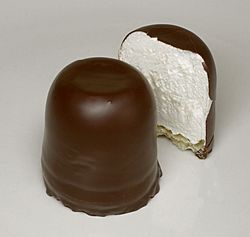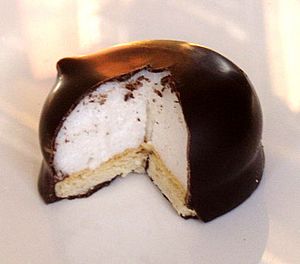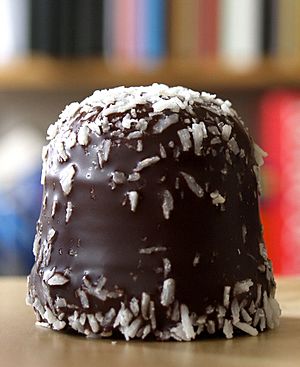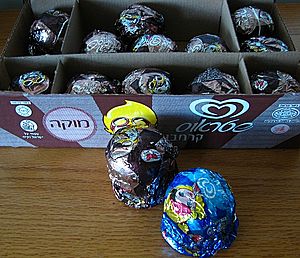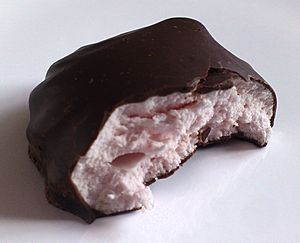Chocolate-coated marshmallow treats facts for kids
Chocolate-coated marshmallow treats are yummy sweets. They have a biscuit (cookie) at the bottom. On top of the biscuit is a soft, fluffy filling like marshmallow. Then, the whole thing is covered in a hard layer of chocolate. These treats were first made in Montreal, Canada, by a company called Viau in 1901.
Contents
- Different Kinds of Chocolate Marshmallow Treats
- Whippets: Canada's Sweet Treat
- Mallomars: A US Favorite
- Schokokuss: Germany's Chocolate Kiss
- Tunnock's Teacake: A Scottish Icon
- Tarboosh: Lebanon's Sweet Treat
- MallowPuffs: New Zealand's Delight
- Négercsók: Hungary's Treat
- Flødebolle: Denmark's Cream Bun
- Krembo: Israel's Winter Delight
- Indijančki: Slovenia's "Little Indians"
- Melo-Cakes: Belgium's Brand
- Choco Mallows: Philippines' Year-Round Treat
- Beso de Negro: Bolivia's Version
- Beso de Moza: Peru's "Girl's Kiss"
- Beso de Negra: Colombia's Treat
- Bombocas: Portugal's Sweet Kisses
- Munchmallow: Serbia's Sweet
- Nhá Benta: Brazil's Dessert
- Ricardito: Uruguay's Treat
- Zefir: Russia's Airy Sweet
- Chocolate Royals: Australia's Treat
- Sweetie Pies: South Africa's Confection
- Other Varieties Around the World
- Chocolate Fish: New Zealand's Unique Shape
- Chocolate Marshmallow Pies
- Images for kids
- See also
Different Kinds of Chocolate Marshmallow Treats
Whippets: Canada's Sweet Treat
Whippet cookies are made in Montreal, Quebec, Canada. They have a biscuit base, a marshmallow-like filling, and a chocolate coating.
Whippets first appeared in stores in 1927. However, the Viau company had been making them since 1901 under the name "Empire." Today, Dare Foods owns the Viau factory in Montreal. Whippets now come with dark or milk chocolate. Some even have fruit jam inside the marshmallow!
These cookies are a special part of Montreal's culture. They don't travel well because the real chocolate melts easily. Also, the air-filled marshmallow can make them break in airplane cargo areas. But you can find them in many grocery stores across Canada and the US.
In Montreal, some English speakers jokingly call them "Nun's Farts." This is because the dark chocolate and white marshmallow look like the black and white clothes of some nuns. Plus, they are light and airy.
The TV show How It's Made once showed how Whippets are made. But they kept some secrets about the recipe!
Another Canadian cookie, "Viva Puffs," is also made by Dare Foods. These are known as "chocolate puffs" in Canada.
Mallomars: A US Favorite
In the United States, Nabisco makes Mallomars. They have a round graham cracker base with marshmallow on top. Then, they are covered in a thin layer of dark chocolate. Mallomars were first sold in 1913 in New Jersey.
Mallomars are usually sold only from October to April. They are not sold in summer because they can melt easily. Many fans buy extra in winter and keep them in the fridge for summer! Most Mallomars are sold in the New York area. They are actually made in Canada, in Scarborough, Ontario.
Schokokuss: Germany's Chocolate Kiss
In Germany, the Schokokuss (meaning "Chocolate Kiss") was first made for sale in 1920. But people talked about them as early as 1892. Big factories started making them in the 1950s. About one billion of these sweets are made each year! That means Germans eat about a dozen per person every year. You can find them in supermarkets, bakeries, and at fairs.
Sometimes, kids like to eat them squished between two halves of a bun. This is called a Matschbrötchen ("Mud Roll"). The inside is always sweet egg white foam. Some versions use sugar substitutes.
Older names for this treat, like Mohrenkopf ("Moor's Head") and Negerkuss ("Negro's Kiss"), are now considered racist. Most companies have changed the names to Schokokuss or Schaumkuss ("Foam Kiss").
In some parts of Switzerland, they are still called Mohrenkopf. In French-speaking Switzerland and France, they are known as Têtes Choco ("chocolate heads").
Tunnock's Teacake: A Scottish Icon
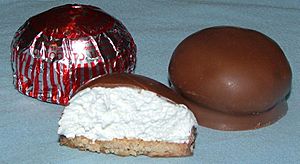
Scottish chef Boyd Tunnock created the Tunnock's teacake in 1956. He used Italian meringue (a type of whipped egg white) on a biscuit base. Then, he covered it in milk chocolate. In the UK, this is called a chocolate teacake. It's different from the usual English teacake, which is a sweet bun with dried fruit.
Tunnock's is the most famous maker of these teacakes. They are very popular across the UK, especially in Scotland. They remind many Scots of their childhood or home. The Scottish National Blood Transfusion Service even gives Tunnock's Teacakes to blood donors! There are fan clubs for them, and giant dancing Tunnock's Teacakes were part of the 2014 Commonwealth Games opening ceremony in Glasgow.
A Tunnock's teacake has a small round shortbread biscuit base. On top is a soft, fluffy dome of Italian meringue. This meringue is more delicate than marshmallow because it's made with egg white, not gelatin. Then, it's covered in milk or plain chocolate. The milk chocolate ones come in a red and silver wrapper, and the plain chocolate ones in blue and gold. Some other brands add jam in the middle.
There was a big legal case about whether the teacake was a "biscuit" or a "cake" for tax reasons. Cakes are not taxed, but chocolate-covered biscuits are. After many years, it was decided that teacakes are cakes!
Tarboosh: Lebanon's Sweet Treat
In Lebanon, a treat called ras el abd (meaning "slave's head") started selling in the 1950s. This name has since been changed to Tarboush (Fez), but some people still use the old name.
MallowPuffs: New Zealand's Delight
Since the 1960s, Griffin's in New Zealand has made MallowPuffs. They are described as "light fluffy marshmallow sitting on top of a shortcake biscuit, covered in luxurious milk chocolate." The marshmallow in MallowPuffs is often a bit firmer than in other similar treats. They come in many flavors like Cookies and Cream, Hokey Pokey, and Rocky Road. Their old advertising slogan, "Have you done enough for a MallowPuff," became a popular saying in New Zealand.
Négercsók: Hungary's Treat
In Hungary, this treat is called négercsók ("Negro kiss"). It was first made in 1980 and was very popular. The way they were made was based on a Danish example. Production slowed down in the 1990s when more sweets from other countries became available.
Flødebolle: Denmark's Cream Bun
In Denmark, this treat was first made with cream, so it was called flødeboller (cream buns). Later, egg whites were used for the filling to make them easier to produce and last longer. In some parts of Denmark, especially around Copenhagen, they were once called negerbolle (negro bun) or negerkys (negro kiss). However, these names were stopped by major producers in the 1960s to 1980s because they are considered racial slurs.
Denmark is one of the biggest makers of these treats. They produce about 800 million every year! The largest Danish producer, Elvirasminde, makes about 650 million. Danes eat about 45 flødeboller per person each year.
In Denmark, children traditionally hand out chocolate-coated marshmallow treats at school on their birthday. You can find them in any supermarket. They are also a popular topping for ice cream cones. Many people enjoy making them at home, and it was even a challenge on the Danish TV show Den store Bagedyst (The Great Bake Off).
There are many kinds of flødeboller. They can have white, dark, or even licorice chocolate coatings, with or without sprinkles. The base is often a plain wafer, but homemade ones might have shortbread or marzipan biscuits. The filling can also be flavored, like licorice or marzipan. They come in different shapes too, from wide and flat to tall like a Christmas tree.
Recently, fancy versions have become popular. These have a much thicker layer of high-quality chocolate and many toppings, like nuts or even tiny pieces of gold. The biscuit base is often replaced with Marzipan. These luxury treats are now found in most supermarkets.
Krembo: Israel's Winter Delight
Krembo is a chocolate-coated marshmallow treat popular in Israel, especially in winter. A Krembo has a round biscuit base, a fluffy marshmallow-like foam, and a thin layer of chocolate. It's wrapped in colorful foil. The most popular flavors for the foam are vanilla and mocha.
A study found that most Israelis (69%) eat Krembos from the top down (starting with the cream). Only 10% start with the biscuit.
Krembo's Story
Chocolate-coated marshmallow treats were popular homemade sweets in Palestine before Israel was formed. They were known by names that are now considered offensive. Mass production started in 1966. The first company, Whitman, named it Krembo. In Hebrew, krembo means "cream in it." A mocha flavor was added in 1967. Today, Strauss is the main maker of Krembos in Israel.
Krembos are a seasonal treat, sold only from October to February. Still, 50 million Krembos are sold each year! That's about 9 per person. They are also sent to the United States and Canada, where they are sold in kosher shops.
What's in a Krembo?
An average Krembo weighs about 25 grams (0.92 ounces). It has about 115 calories.
Religious Rules for Eating Krembo
For Jewish people who follow Jewish law, there's a discussion about how to say blessings when eating a Krembo. Different parts of the Krembo need different blessings. Some rabbis say you should bless each part separately.
Indijančki: Slovenia's "Little Indians"
In Slovenia, these sweets are called indijančki, which means "little Indians."
Melo-Cakes: Belgium's Brand
In Belgium, the Milka company sells these treats under the name Melo-Cakes. They come in packs of 6 or even 30.
Choco Mallows: Philippines' Year-Round Treat
In the Philippines, Fibisco makes Choco Mallows, which are similar to Mallomars. Unlike Mallomars, they are sold all year. Because the Philippines has a warm climate, the chocolate coating usually stays soft, even when refrigerated.
Beso de Negro: Bolivia's Version
In Bolivia, Chocolates Condor traditionally makes "Beso de Negro" (Negro Kiss). This treat uses a sweetened egg white foam filling, like the German Schokokuss. While there have been new flavors, the classic version is still the most popular.
Beso de Moza: Peru's "Girl's Kiss"
In Peru, these sweets are called "Beso de Moza" (Girl's Kiss) and are sold by Nestlé. There's even a contest to see if strawberry or lucuma flavors will become permanent!
Beso de Negra: Colombia's Treat
In Colombia and Ecuador, it's called Beso de Negra (Black Woman's Kiss) or "Chocmelo." The name "Chocmelo" comes from "chocolate" and "masmelo" (marshmallow). These don't always have a cookie base.
In 2020, Nestlé announced they would change the name and packaging of "Beso de Negra" because of concerns about the image and name.
Bombocas: Portugal's Sweet Kisses
In Portugal, these are known as "Bombocas." Different brands sell them, often in supermarkets. They come in meringue (white inside), strawberry (pink), and vanilla (yellow) flavors. Recently, they've also been called "Beijinhos" (little kisses).
Munchmallow: Serbia's Sweet
Made in Serbia by Jaffa, Munchmallow has a biscuit base and a soft marshmallow filling covered in chocolate. It's very similar to the Tunnock's teacake from Scotland.
Nhá Benta: Brazil's Dessert
In Brazil, this dessert is called Nhá Benta and is made by Kopenhagen. Other versions exist, like Cacau Show's Montebello and Dan-Top, which made the treat very popular in Brazil. They come in many flavors like coconut, lemon, and coffee. It is also known by an old name, "teta-de-nega" ("black woman's tit").
Ricardito: Uruguay's Treat
In Uruguay, it's called "Ricardito." It's meringue covered in chocolate, made by Ricard.
Zefir: Russia's Airy Sweet
Zefir is a sweet made from fruit puree, sugar, and whipped egg whites. It's popular in countries that used to be part of the Soviet Union. It's like a mix of a traditional Russian sweet called pastila and French meringue. The name comes from Zephyr, the Greek god of the west wind, because of its light, airy texture.
Zefir is similar to marshmallows or Schokokuss. It often looks like meringue but is never crispy. You can find it plain or chocolate-coated. Unlike other treats on this list, it doesn't have a biscuit base.
Chocolate Royals: Australia's Treat
Arnott's Chocolate Royals are Australia's chocolate-coated marshmallow treat. They come in milk and dark chocolate and look like a Tunnock's teacake.
Sweetie Pies: South Africa's Confection
In South Africa, a similar sweet is called Sweetie Pies. Cadbury's first made them, but now Beyers makes them.
Other Varieties Around the World
In Iran, this is a popular treat for children. It's often called بستنی زمستانی (meaning "winter ice cream").
In Turkey, there isn't one common name. People might call it by brand names like "Çokomel."
Chocolate Fish: New Zealand's Unique Shape
In New Zealand, a common chocolate-coated marshmallow treat is the chocolate fish. It's shaped like a fish, about 12 to 20 centimeters (5 to 8 inches) long. It's made of pink or white marshmallow covered in milk chocolate. The chocolate has ripples that look like fish scales.
In New Zealand culture, a chocolate fish is often given as a small reward for doing a good job. People might say, "Give that kid a chocolate fish!" even if they don't have one to give. It's a way to say "well done!"
Chocolate Marshmallow Pies
Chocolate marshmallow pies are a bit different. They have a cake or cookie layer *above* and *below* the marshmallow filling. So, the marshmallow is sandwiched between two layers, and then the whole thing is covered in chocolate. Some names for these pies are:
- "Chocolate marshmallow pie" (a general name) in the United States.
- "Moon Pie" (a brand name) in the United States, especially in the Southern states.
- "Scooter Pie" (a brand name) in the United States, especially in the Northeast.
- "Choco pie" (a brand name that became a common name) in South Korea, Russia, and parts of Asia.
- "Angel pie" (a brand name) in Japan.
- "Wagon Wheels" (a brand name) in the United Kingdom, Canada, Australia, and other countries.
Images for kids
See also
 In Spanish: Beso de moza para niños
In Spanish: Beso de moza para niños


